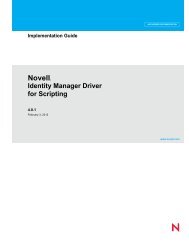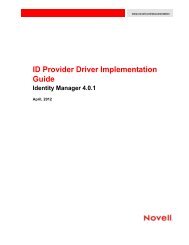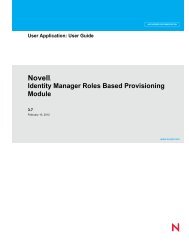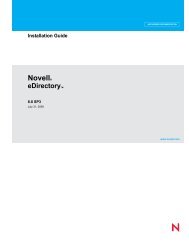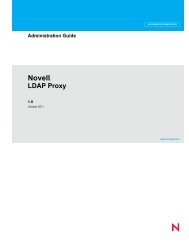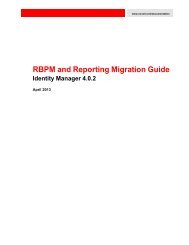Novell eDirectory 8.8 Troubleshooting Guide - NetIQ
Novell eDirectory 8.8 Troubleshooting Guide - NetIQ
Novell eDirectory 8.8 Troubleshooting Guide - NetIQ
Create successful ePaper yourself
Turn your PDF publications into a flip-book with our unique Google optimized e-Paper software.
Option<br />
Base DN<br />
Scope<br />
Description<br />
Base distinguished name for the search request<br />
If this field is left empty, the base DN defaults to " " (empty string).<br />
Scope of the search request<br />
novdocx (en) 22 June 2009<br />
Filter<br />
Attributes<br />
RFC 2254-compliant search filter<br />
The default is objectclass=*.<br />
Attributes you want returned for each search entry<br />
9 Click Next.<br />
10 Specify the LDAP server where the data will be migrated.<br />
11 Click Next, then click Finish.<br />
NOTE: Ensure that the schema is consistent across LDAP Services.<br />
Using the <strong>Novell</strong> Import Conversion Export Utility Command Line Interface<br />
To enable forward references in the command line interface, use the -F LDAP destination handler<br />
option.<br />
For more information, see “LDIF Destination Handler Options” in the <strong>Novell</strong> <strong>eDirectory</strong> <strong>8.8</strong><br />
Administration <strong>Guide</strong>.<br />
5.2.2 Checking the Syntax of LDIF Files<br />
You can check the syntax of an LDIF file before you process the records in the file by using the<br />
Display Operations But Do Not Perform LDIF source handler option.<br />
The LDIF source handler always checks the syntax of the records in an LDIF file as it processes<br />
them. Using this option disables the processing of the records and lets you verify the syntax.<br />
Using the <strong>Novell</strong> <strong>eDirectory</strong> Import Convert Export Wizard<br />
1 In <strong>Novell</strong> iManager, click the Roles and Tasks button .<br />
2 Click <strong>eDirectory</strong> Maintenance > Import Convert Export Wizard.<br />
3 Click Import Data from File on Disk, then click Next.<br />
4 Select LDIF as the type of file you want to import.<br />
5 Specify the name of the file containing the data you want to import, specify the appropriate<br />
options.<br />
6 Under Advanced Settings, click Display Operations But Do Not Perform, then click Next.<br />
7 Specify the LDAP server where the data will be imported.<br />
8 Add the appropriate options, as described in the following table:<br />
<strong>Troubleshooting</strong> LDIF Files 37




